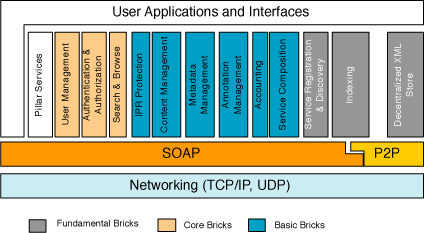|
|

| |
| < Contents ERCIM News No. 61, April 2005 |
R&D and TECHNOLOGY TRANSFER
|
|
| |
BRICKS: A Digital Library Management System for Cultural Heritage
by Carlo Meghini and Thomas Risse
The aim of the BRICKS project is to design and develop an open, user- and service-oriented infrastructure to share knowledge and resources in the Cultural Heritage domain. BRICKS will provide cultural heritage institutions and users the possibility to share their content and services with other users.
BRICKS (Building Resources for Integrated Cultural Knowledge Services) is an Integrated Project of the 6th Framework Programme (IST 507457) within the research and technological development programme 'Integrating and Strengthening the European Research Area (2002-2006)'. BRICKS began in January 2004 and has a duration of 42 months. The BRICKS Consortium consists of 24 partners; 7 from academia, and the rest equally distributed between users and industry, mostly SMEs. The target audience is very broad and heterogeneous and involves cultural heritage and educational institutions, the research community, industry, and citizens. The project is coordinated by Engineering SpA, Italy.
Requirements
The BRICKS infrastructure will use the Internet as a backbone and has been designed to enable:
- Expandability, which means the ability to acquire new services, new content, or new users, without any interruption of service
- Graduality of Engagement, which means offering a wide spectrum of solutions to the content and service providers that want to become members of BRICKS
- Scalability
- Availability
- Interoperability.
In addition, the user community requires that an institution can become a member of a BRICKS installation with minimal investments, and that the maintenance costs of the infrastructure, and in consequence the running costs of members are minimal. BRICKS membership will also be flexible; parties can join or leave the system at any point in time without administrative overheads.
Approach
It has been decided that the BRICKS architecture will be decentralised, based on a peer-to-peer (P2P) paradigm, ie no central server will be employed. Every member institution of a BRICKS installation is a node (a BNode in the BRICKS jargon) of the distributed architecture. BNodes use available resources for content and metadata management. A single BNode only has direct knowledge of a subset of other BNodes in the system. However, if a BNode wants to reach a member with which it is not in direct communication, it will forward a request to some of its known neighbour BNodes; these will deliver the request to the final destination or forward again to other nodes.
The Bricks of BRICKS
The figure shows the architecture of a BNode. The components (bricks, in the BRICKS jargon) making up the architecture are Web Services, and are divided into 3 broad categories:
- Fundamental bricks; these are required on a BNode for its proper functioning and to maintain membership in the community. In addition to the P2P layer, other fundamental services are: Decentralised XML Storage (providing data ubiquity on the P2P architecture), Service Registration and Discovery, and Index management
- Core bricks; these are needed if a local BNode installation wants to provide its local users with access to BRICKS. They include: User Management, Authentication and Authorisation, and Search and Browse
- Basic bricks: these are optional, and are deployed on the BNode only if needed (ie the Content Management brick will be deployed only if the institution running the BNode exposes content to the BRICKS installation). They include: Content Management, Metadata Management, Accounting, IPR Protection, Annotation Management, and Service Composition.
 |
| Architecture of a BNode. |
|
Pilot Applications
In order to render BRICKS operational in the Cultural Heritage domain, the project will develop 4 applications (Pillars, in the BRICKS jargon):
- Archaeological Site, which includes four scenarios: Cultural Landscape Discoverer (sharing knowledge about cultural landscapes), Finds Identifier (identification of objects brought to a museum by members of the public), Landscapes Reconstructed (reconstruction of knowledge about cultural landscapes), and Pompeii and Roma (access to visual artefacts)
- The European Museum Forum, which aims at introducing a digital application process for the European Museum of the Year Award
- Living Memory, which aims at developing a collaborative environment targeted at the general public, and allowing the creation of cultural contents and their sharing among the rest of the community
- Scriptorium, which will facilitate the work of historians and archive professionals, universities, cultural research centres, libraries, history professors and teachers, and others, through the definition of a new way to exploit and manage Distributed Digital Texts and historical documents. The specific scenario will be the creation of a critical edition of an ancient manuscript.
Link:
BRICKS Community: http://www.brickscommunity.org/
Please contact:
Carlo Meghini, ISTI-CNR, Italy
Tel: +39 050 315 2893
E-mail: carlo.meghini isti.cnr.it isti.cnr.it
Thomas Risse, Integrated Publication and Information Systems Institute -IPSI, Fraunhofer ICT Group
Tel: +49 (0) 6151 / 869-906
E-mail: risse ipsi.fraunhofer.de ipsi.fraunhofer.de
|
| |
|

|



